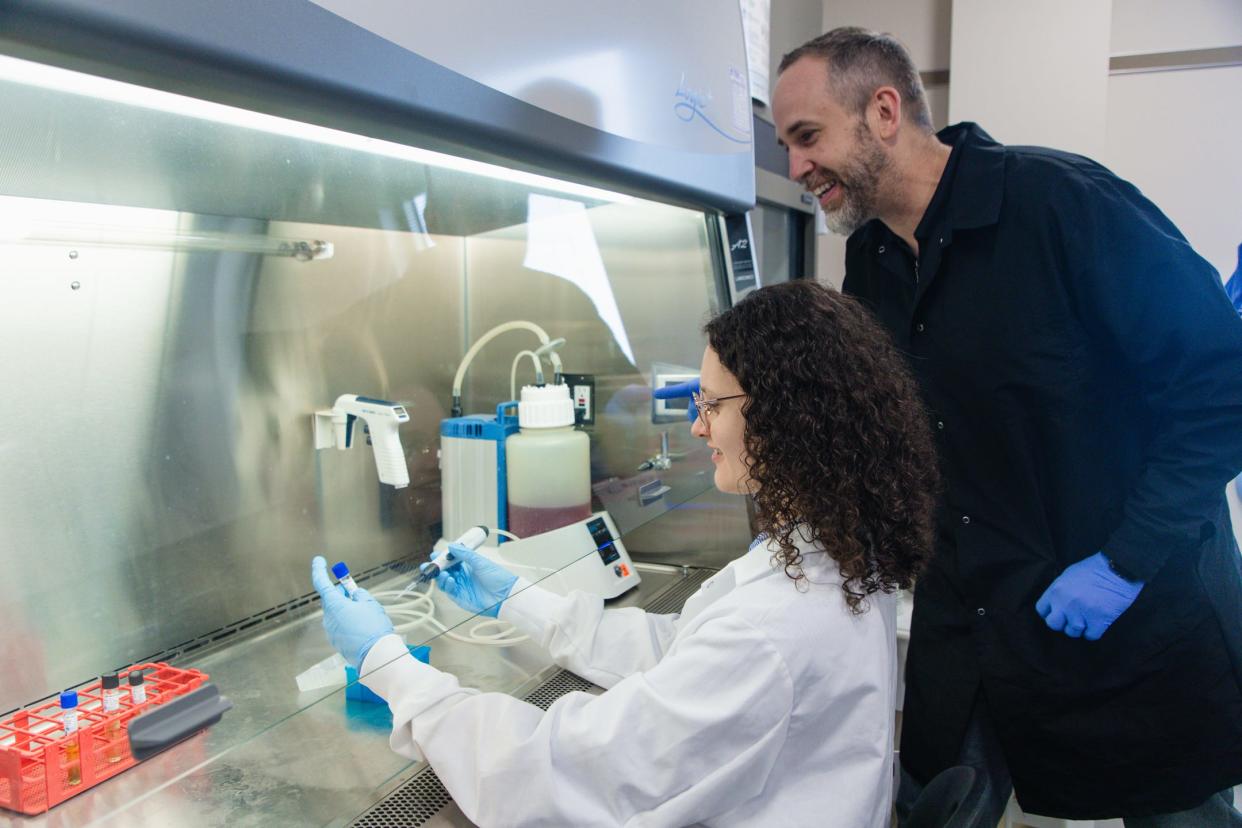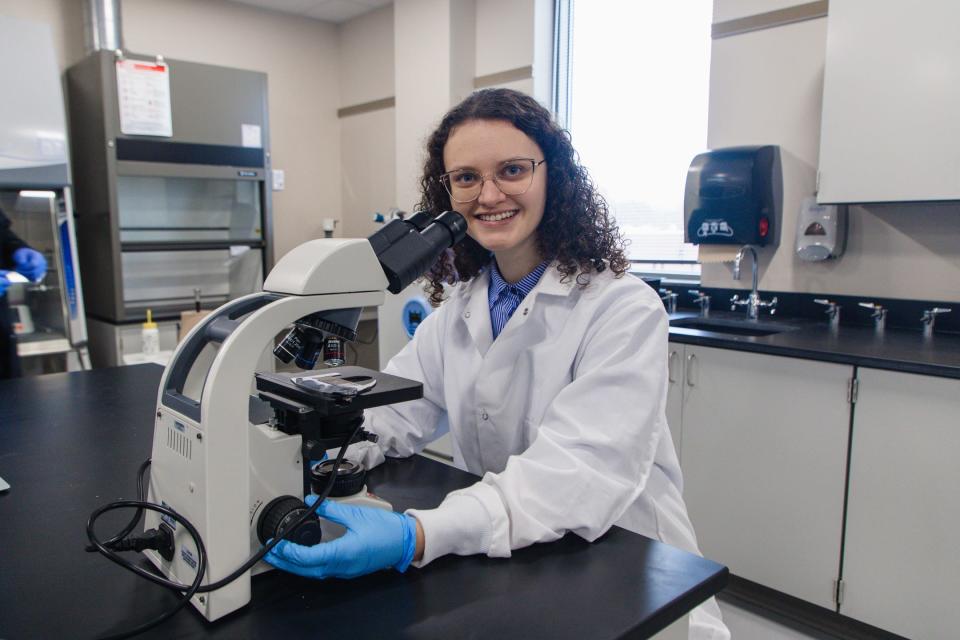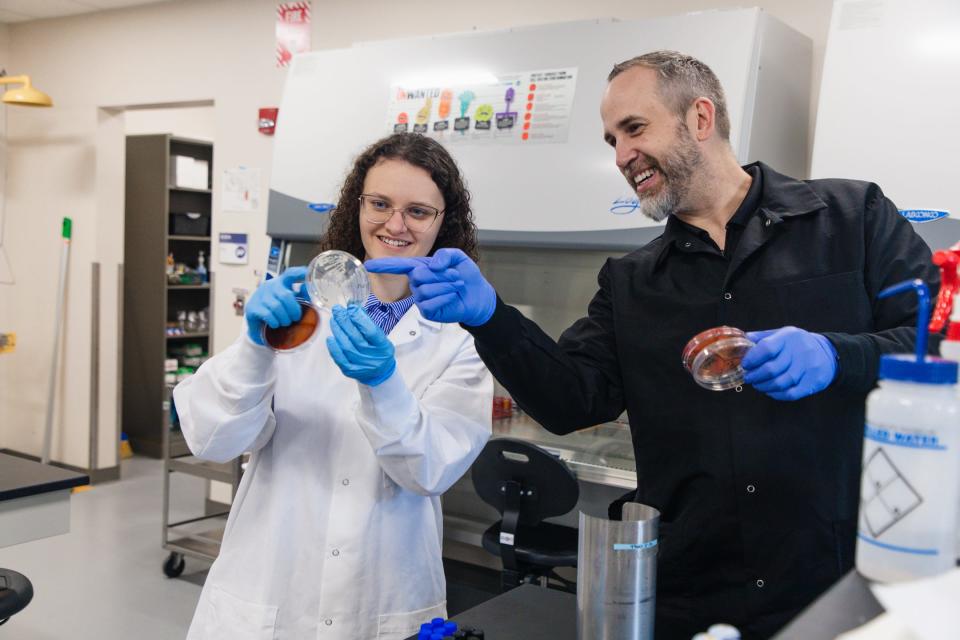2 NWTC students found a new antibiotic in soil at Pamperin Park. Here's why it's so groundbreaking.

GREEN BAY - In the summer of 1932, T.A and Nellie Pamperin donated 6.4 acres of land to the city to create a public park, which turned into Pamperin Park in Howard.
Over 90 years later, the park has become the site of a landmark discovery unearthed by the Pamperin family generations later — Justyna Kakol, whose fiancé's grandmother is a relative of T.A Pamperin, discovered a new antibiotic in the park's soil.
Kakol and Mainor Vang, who are both undergraduate students at Northeast Wisconsin Technical College, discovered the antibiotic at a time when the world faces dwindling treatments to serious infections as resistance to antibiotics reaches an all-time high.
Kakol and Vang's work was published in August and September this year in the peer reviewed scientific journal, microPublication Biology, which is a first for Wisconsin. It's the first time students at a technical college have ever been published for scientific research.
Typically, undergrad students don't get a lot of opportunities to join research labs until they graduate. Many people may not see an opportunity to do research at the same level of universities at a technical college, either, said Angelo Kolokithas, program director of biology at NWTC.
"It's history making because it's just unheard of," Kolokithas said.

From soil to treatment
Kakol and Vang are part of the Tiny Earth program at NWTC, which is based at the University of Wisconsin-Madison and does research to find solutions in the antibiotic crisis and improve soil health. NWTC is one of over 30 colleges and universities worldwide involved in Tiny Earth.
As part of the program, students collect soil and take it back to the lab for testing. Most of the antibiotics used today come from microbes, or microscopic organisms. They are produced in nature and over two-thirds of antibiotics, such as penicillin, come from soil bacteria and fungi.
Kakol noticed activity in the soil she collected from Pamperin Park and was able to isolate the compound. The next step in the process involved testing the antibiotic to see if it killed bacteria of common pathogens while it remained active.
A critical part of testing is seeing if the antibiotic is toxic to human cells — many antibiotics that get discovered don't move on in the process because they are found to be dangerous to people.
"Ninety-nine percent of the time it's also toxic to humans so it's very significant that we got past that," Kolokithas said.
Kakol designed a set of experiments to test the antibiotics' toxicity and when she saw they passed the tests, she repeated the experiments over and over again to make sure the results were real.
"At first, we didn't believe our eyes," Kakol said.
The antibiotic that Kakol and Vang discovered defends against relatives of highly harmful bacteria, known as the six ESKAPE pathogens. They are bacteria that have mutated against most, if not all, antibiotics and don't have a cure.
The bacteria in Pamperin Park has not been found in the U.S. before, Kolokithas said, though he's not surprised it was found in Wisconsin. It was originally detected in North Korea and is used to metabolize nicotine in dumps and was never previously shown to produce antibiotics, which means there's potential for more discoveries in the bacteria. Nicotine is prevalent everywhere, so it's a "matter of time" until people look for it specifically elsewhere in the country and detect it, Kolokithas said.

Antibiotics have stopped working: A worldwide crisis
People are in a molecular race against time. Bacteria are evolving faster than the level of antibiotic discovery, and antibiotic resistance has become a "fundamental threat" to humanity, according to the World Health Organization.
In the latest report from the Centers of Disease Control and Prevention, more than 2.8 million infections that are resistant to antibiotics happen each year in the U.S. More than 35,000 people die from such infections.
Worldwide, antimicrobial resistance killed at least 1.27 million people in 2019.
Overuse and misuse of antibiotics by people and animals and the effects of the pandemic have worsened the crisis and pushed the need to develop new antibiotics.
"Sometimes we don't use them correctly," Kakol said. "Some people start them and never finish them as soon as they feel better but it's important to finish the series."
Half of the antibiotics typically used today were found between 1950 and 1960, which was considered the golden age of antibiotic discovery.
The last class of antibiotics used as treatment was developed in 1987. So, Kolokithas hopes Kakol and Vang's discovery encourages more students to join research through Tiny Earth at NWTC.
The isolated bacteria Kakol and Vang researched will be sent to UW-Madison for further testing and it's unclear if UW-Madison's testing process includes getting additional soil samples from Pamperin Park. If all goes well, it may become a treatment used for bacterial diseases.
Kakol didn't expect to publish so soon. She graduated from NWTC in May and hopes to continue studying microbiology. She hopes further testing of the bacteria is successful so it can become another opportunity for treatment.
"It can help communities all over the world," Kakol said.
Learn more about the discoveries at the Tiny Earth Symposium
Students will present their research from 5-7:30 p.m. Dec. 11 at the Tiny Earth Winter Symposium at Lambeau Field in Green Bay. Students from UW-Green Bay, NWTC, College of Menominee Nation, St. Norbert College and Green Bay West High School are part of the symposium.
Prevea Health president and CEO Dr. Ashok Rai is the keynote speaker.
Registration to the symposium is free. Sign up at www.tinyearth.wisc.edu/2023-tiny-earth-in-titletown.
Benita Mathew is a health reporter for the USA TODAY NETWORK-Wisconsin. Contact her at bmathew@gannett.com. Follow her on Twitter @benita_mathew.
This article originally appeared on Green Bay Press-Gazette: Two NWTC students find new antibiotic in Pamperin Park in Howard

